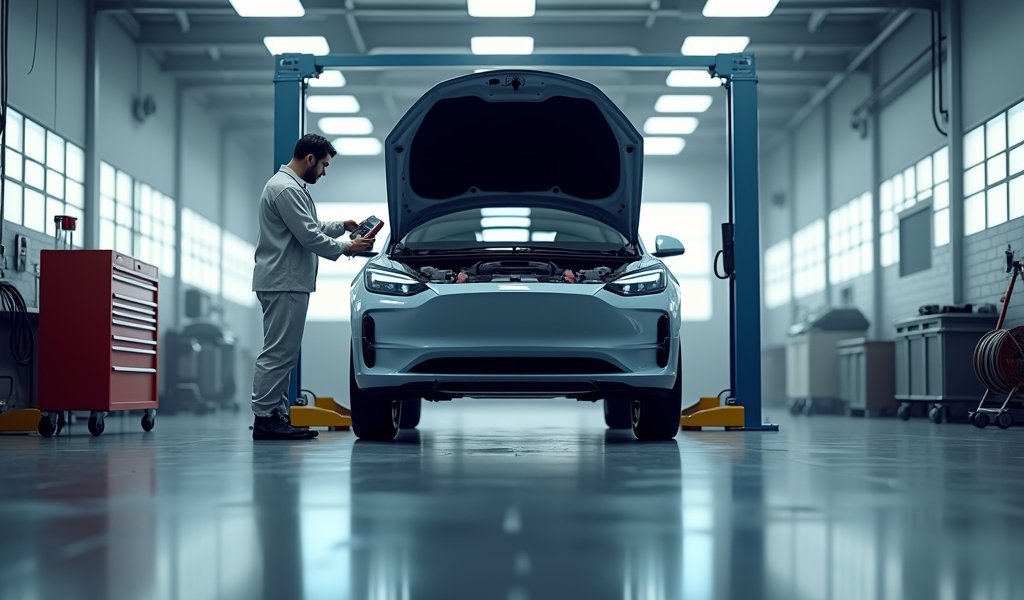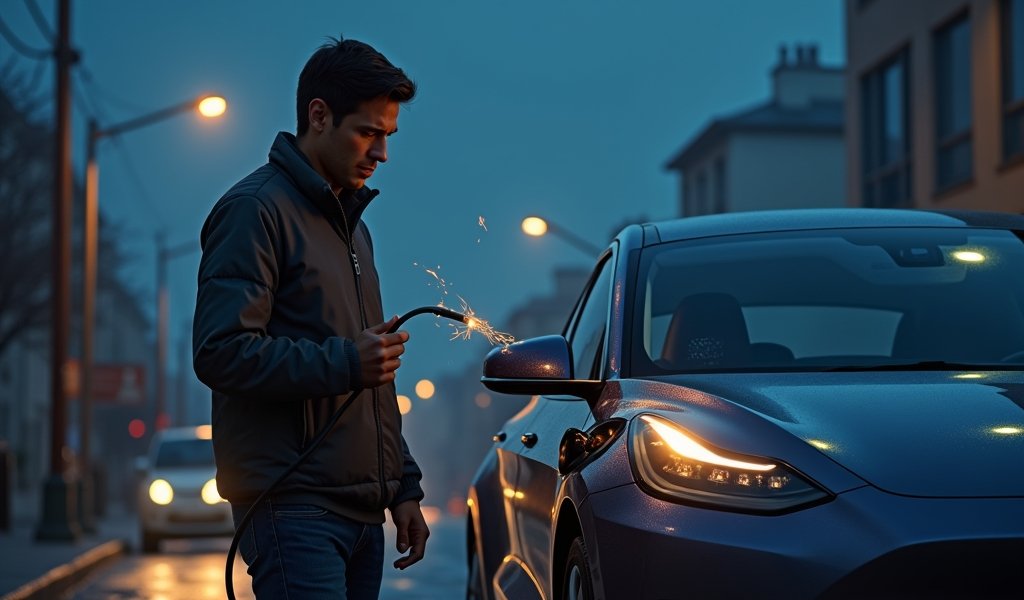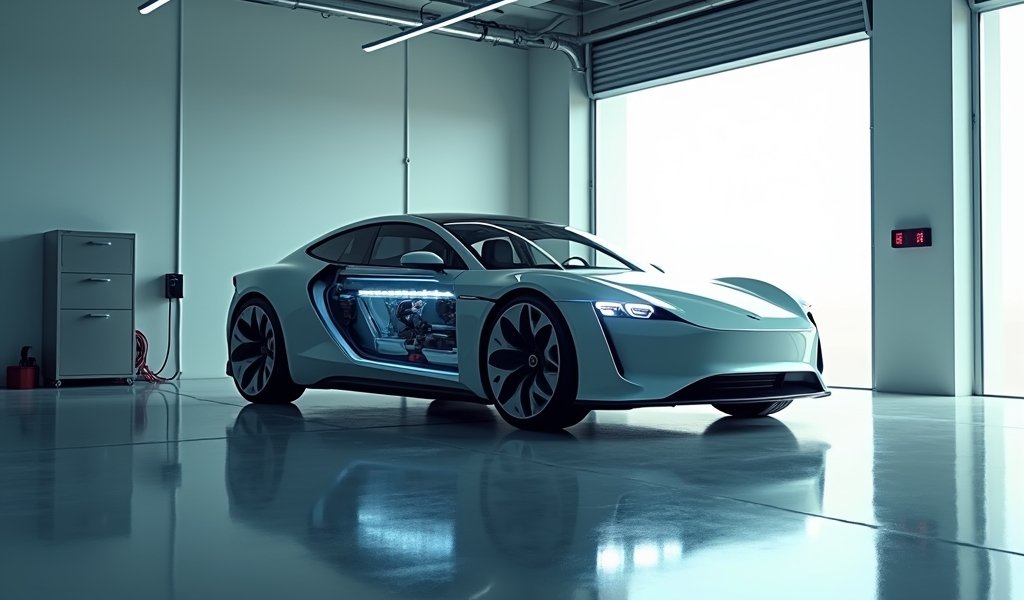Overview
Electric vehicles require a different maintenance approach than traditional cars, focusing on battery care, tire maintenance, occasional brake exercise, cooling system integrity, and software updates rather than regular part replacements. EV maintenance is simpler and costs about 40% less over a vehicle’s lifetime, with longer intervals between service visits (10,000-15,000 miles) and no need for oil changes, though proper charging habits and temperature management are crucial for maximizing battery performance and longevity.
Table of Contents
- Understanding EV Maintenance: A New Approach
- Battery Care: Your EV’s Lifeline
- Tire Maintenance for Electric Vehicles
- The Unique World of EV Brake Maintenance
- Cooling System Care: Protecting Your Investment
- Software Updates: Digital Maintenance Matters
- Seasonal Preparations for Your Electric Vehicle
- DIY vs. Professional Maintenance
- Conclusion
- Frequently Asked Questions
Understanding EV Maintenance: A New Approach
When you switch from a gas-powered car to an electric vehicle, it’s like trading in your trusty landline for a smartphone. Sure, they both make calls, but the maintenance approach is entirely different. As someone who’s had their hands under the hoods of both types for decades, I can tell you that electric car maintenance requires a mental shift.
Electric vehicles have far fewer moving parts than their combustion counterparts. No more oil changes, spark plug replacements, or timing belt services. But don’t be fooled – these high-tech machines still need proper care to perform their best.
The beauty of EV maintenance is its simplicity. While traditional vehicles might need service every few thousand miles, electric cars often go 10,000-15,000 miles between check-ups. This simplicity translates directly to your wallet too – EV owners typically spend about 40% less on maintenance over their vehicle’s lifetime.
However, simplicity doesn’t mean neglect. Your EV has unique needs that require attention, just of a different variety. Think of it as caring for a sophisticated computer rather than a mechanical beast. In my two decades of working on vehicles, I’ve seen this transition reshape how we approach vehicle care – and it’s refreshingly straightforward when you understand the basics.
Battery Care: Your EV’s Lifeline
If there’s one component that deserves your utmost attention, it’s the battery pack – the beating heart of your electric vehicle. Like a marathon runner who carefully manages their energy, how you charge and use your EV battery directly impacts its performance and longevity.

For daily driving, aim to keep your battery charge between 20% and 80%. This “Goldilocks zone” is where lithium-ion batteries are happiest. I’ve seen too many new EV owners treating their car batteries like smartphone batteries, regularly draining to zero and charging to 100%. Unlike your phone, consistently charging to 100% can accelerate battery degradation in your EV.
When it comes to charging habits, think of DC fast charging stations as the fast food of the EV world – convenient in a pinch but not great for regular consumption. The heat generated during rapid charging can stress battery cells over time. Instead, rely primarily on Level 2 home charging for your daily needs, saving those fast chargers for road trips and emergencies. Your car’s battery health will thank you.
Temperature management also plays a crucial role in battery preservation. Extreme heat and cold are the enemies of battery chemistry. Whenever possible, park in garages or shaded areas during hot weather, and use pre-conditioning features when plugged in during cold months. Many EVs allow you to warm the battery while still connected to power, which preserves your range for actual driving.
Most modern EVs come with built-in battery management systems that handle the heavy lifting, but your charging habits remain the single biggest factor in battery longevity. Studies by the U.S. Department of Energy confirm that proper charging habits can extend battery life by years, not just months.
Tire Maintenance for Electric Vehicles
If you’ve noticed your tires wearing faster on your EV than your previous gas-powered vehicle, you’re not imagining things. Electric cars are typically heavier due to their battery packs, and they deliver instant torque to the wheels – a perfect recipe for increased tire wear.
Tire pressure becomes even more critical with electric vehicles. Underinflated tires don’t just wear faster; they significantly reduce your driving range. I always tell my customers that properly inflated tires can improve efficiency by up to 10% – that’s free miles without changing anything else! Check your tire pressure at least monthly, and always before long trips.
Rotation patterns matter more with EVs too. Because of their unique weight distribution and the effects of regenerative braking, electric vehicles tend to wear front tires faster than rear ones. I recommend a rotation every 6,000-7,000 miles to ensure even wear and maximum tire life.
When shopping for replacement tires, consider EV-specific options. These specialized tires feature lower rolling resistance compounds and reinforced sidewalls designed to handle the additional weight and torque characteristics. They might cost a bit more upfront, but the improved efficiency and longer wear make them worth considering.
Remember that your choice of tires affects more than just wear – it directly impacts range, road noise, and handling. The difference between budget tires and quality EV-specific rubber can be as much as 5-7% of your vehicle’s range. As someone who’s tested dozens of tire combinations on EVs, I can attest that the right tires make a substantial difference in the ownership experience.
The Unique World of EV Brake Maintenance
Here’s something that surprises many first-time EV owners: your brake pads will last significantly longer than in a conventional car. Why? Regenerative braking means you’re using the electric motor to slow down, not just the friction brakes.
This regenerative braking system is like having an invisible helper that both slows your car and recharges your battery. In city driving, you might use your actual brakes 50-80% less than in a gas car. I’ve seen EVs come in for their 50,000-mile service with brake pads that look practically new.
However, this reduced usage creates a unique challenge – brake components that rarely see action can develop surface rust and corrosion. The solution? Occasional moderate braking to keep those components clean and functional. Think of it as exercise for components that don’t get their regular workout.
Despite the reduced wear, visual inspections remain important. During seasonal tire changes, have your brake system examined for signs of caliper seizing or rotor corrosion. These issues are more common in EVs precisely because the components see less regular use.
One maintenance tip I give all my EV customers: once a month, find an empty road and perform 2-3 moderate-to-firm stops from about 30 mph. This helps clean the brake rotors and keeps the calipers moving freely. It’s a simple practice that can prevent costly repairs down the road.
Cooling System Care: Protecting Your Investment
While EVs don’t have the complex cooling requirements of combustion engines, they still rely on sophisticated thermal management systems to keep batteries, motors, and electronics at optimal temperatures. Neglecting this system can lead to reduced range, power limitations, or even permanent battery damage.

Most electric vehicles use a sealed cooling system that requires minimal maintenance, but checking coolant levels and condition should be part of your annual service routine. The coolant used in EVs is specially formulated to be electrically non-conductive – never substitute regular automotive coolant if you’re topping off yourself.
Warning signs of cooling system issues include significant range reduction, limited power (especially in hot weather), or warning lights on your dashboard. If you notice any of these symptoms, don’t delay getting it checked. Unlike with gas cars where overheating might just leave you stranded, cooling system problems in an EV can potentially lead to expensive battery repairs.
I recommend having the cooling system inspected annually by technicians familiar with your specific EV model. They can check for leaks, test the coolant condition, and verify that pumps and control systems are functioning correctly. Think of it as preventive medicine – a small investment that protects your much larger battery investment.
For those interested in the technical details, most EVs use a complex system of cooling loops, heat exchangers, and control valves to maintain different components at their ideal temperatures. Research from the Society of Automotive Engineers shows that optimal thermal management can extend battery life by up to 20% while improving charging speeds and performance.
Software Updates: Digital Maintenance Matters
One of the most distinctive aspects of electric vehicle care is the importance of software updates. Your EV is essentially a computer on wheels, and like your laptop or phone, it needs regular updates to function optimally.
Many manufacturers push updates automatically via cellular connections, but some require manual approval or even dealer visits. These updates often do more than fix bugs – they can improve range, enhance charging speeds, add new features, and even address potential safety concerns.
Establishing a routine to check for available updates through your vehicle’s infotainment system or companion app should become a regular maintenance habit. It’s as important as oil changes were for conventional vehicles. Some manufacturers send notifications when updates are available, but it never hurts to check periodically.
I’ve seen cases where software updates improved vehicle efficiency by 5-10% – imagine getting that kind of improvement from a traditional car service! Tesla is particularly known for this approach, where Tesla maintenance costs are offset by continuous improvements through software updates.
When installing updates, ensure your vehicle has sufficient charge (typically 50% or more) and is parked in a location with good connectivity. Updates can sometimes take 30-60 minutes to complete, and you won’t be able to drive during this time. I recommend scheduling them when you know you won’t need your vehicle for a while.
Seasonal Preparations for Your Electric Vehicle
As seasons change, so should your approach to EV care. Unlike gas vehicles that generate excess heat in winter, EVs must use battery power for cabin heating, which can significantly reduce range in cold weather.
For winter driving, precondition your vehicle while still plugged in whenever possible. This allows you to warm the cabin and battery using grid power rather than your battery’s stored energy. Many EVs allow you to schedule this preconditioning through their apps – a feature worth mastering.
Consider using seat heaters instead of cabin heating when possible in winter. They use significantly less energy while keeping you comfortable. Similarly, in summer, pre-cooling your vehicle while plugged in helps preserve range once you’re on the road.
Winter also brings special considerations for charging. Cold batteries charge more slowly, so allow extra time at charging stations when temperatures drop. Some EVs automatically warm the battery when navigating to a charger – a clever feature that improves charging efficiency in cold weather.
For those in regions with harsh winters, I highly recommend garage storage if possible. Not only does it protect your vehicle from the elements, but it also helps maintain a more moderate battery temperature, which improves both performance and longevity.
The seasonal maintenance approach for EVs differs from hybrid car maintenance, which combines aspects of both worlds. Pure EVs require fewer seasonal fluid changes but more attention to battery temperature management and range optimization.
DIY vs. Professional Maintenance
While electric vehicles have fewer serviceable components than gas cars, there’s still plenty of maintenance you can handle yourself. The trick is knowing where to draw the line between DIY tasks and professional service.
Tasks well-suited for DIY maintenance include:
- Tire pressure checks and adjustments (monthly)
- Windshield wiper replacement (as needed)
- Cabin air filter changes (every 12-15,000 miles)
- 12-volt auxiliary battery checks (yes, most EVs still have one!)
- Washer fluid top-ups and exterior cleaning
Leave these tasks to professionals:
- Any work involving the high-voltage system (orange cables)
- Cooling system service or repairs
- Battery diagnostics and cell balancing
- Drive unit (motor) service
- Complex software updates or troubleshooting
Finding qualified technicians for your EV can be challenging outside dealer networks. I recommend researching independent shops that have invested in EV-specific training and equipment. The right shop can save you money while providing expertise comparable to dealerships.
Remember that maintaining service records is particularly important for EVs, as warranty claims for battery issues often require proof of proper maintenance. Additionally, as the EV market matures, comprehensive service history will likely influence resale values significantly.
For those curious about specifics, Consumer Reports found that EV owners spend about $4,600 less on maintenance over a vehicle’s lifetime compared to comparable gas vehicles. Those savings add up quickly, especially when you combine professional service for complex systems with DIY care for the basics.
Conclusion
Maintaining an electric vehicle is less about regular part replacements and more about smart usage patterns and preventive care. The transition from mechanical to electronic maintenance represents one of the most significant shifts in automotive care in a century.
By focusing on proper battery charging habits, tire maintenance, occasional brake exercise, cooling system integrity, and software updates, you’ll ensure your EV delivers optimal performance and longevity. The reduced maintenance burden is one of the most underappreciated benefits of electric vehicle ownership.
While the technology continues to evolve, the fundamental principles remain constant: preventive care is always more cost-effective than reactive repairs. Your electric vehicle may have fewer moving parts, but it still benefits tremendously from thoughtful, consistent maintenance.
As more drivers make the switch to electric, the collective knowledge around best practices will continue to grow. The EV maintenance landscape today is dramatically different from just five years ago, with better tools, more trained technicians, and improved owner resources.
Embrace this simplified approach to vehicle care, and you’ll not only maximize your EV’s performance and lifespan but also enjoy one of the key benefits of electric vehicle ownership – more time driving and less time maintaining.
Frequently Asked Questions
How often do electric cars need maintenance?
Electric vehicles typically require scheduled maintenance every 10,000-15,000 miles or annually. Most EVs need significantly fewer service visits than gas-powered vehicles due to their simpler mechanical design and fewer wear components.
Do electric cars need oil changes?
No, electric cars do not need oil changes since they don’t have internal combustion engines. The electric motor in an EV operates without the need for engine oil lubrication.
How long do EV batteries typically last?
Most modern EV batteries are designed to last 10-15 years or 100,000-200,000 miles before significant degradation. Many manufacturers warranty their battery packs for 8-10 years or 100,000 miles against excessive capacity loss.
Are electric cars more expensive to maintain than gas cars?
No, electric cars are generally 30-40% less expensive to maintain over their lifetime compared to equivalent gas vehicles. They eliminate costs for oil changes, exhaust system repairs, and have significantly reduced brake maintenance needs.
Can I take my electric car to any mechanic for service?
Not all mechanics are qualified to work on electric vehicles, especially for high-voltage system issues. Look for technicians with specific EV certification or training, or consider dealership service centers for complex problems.

